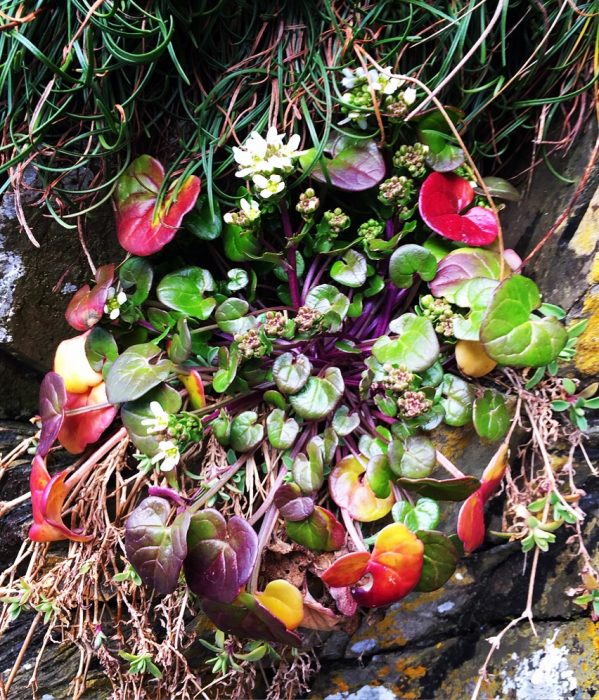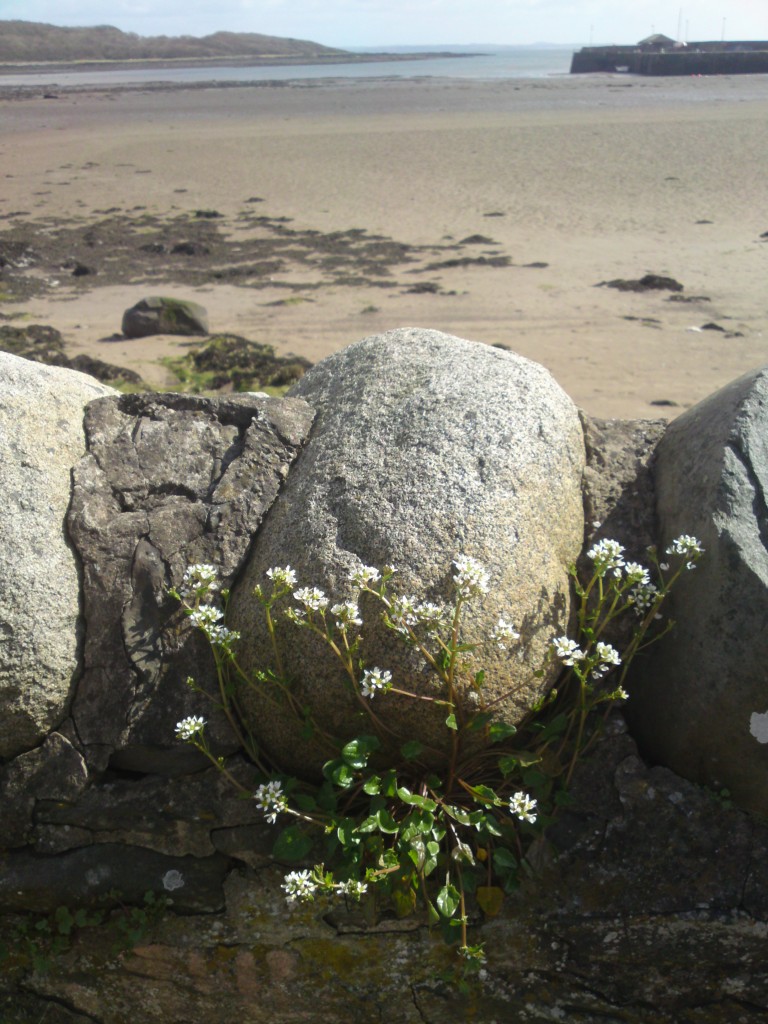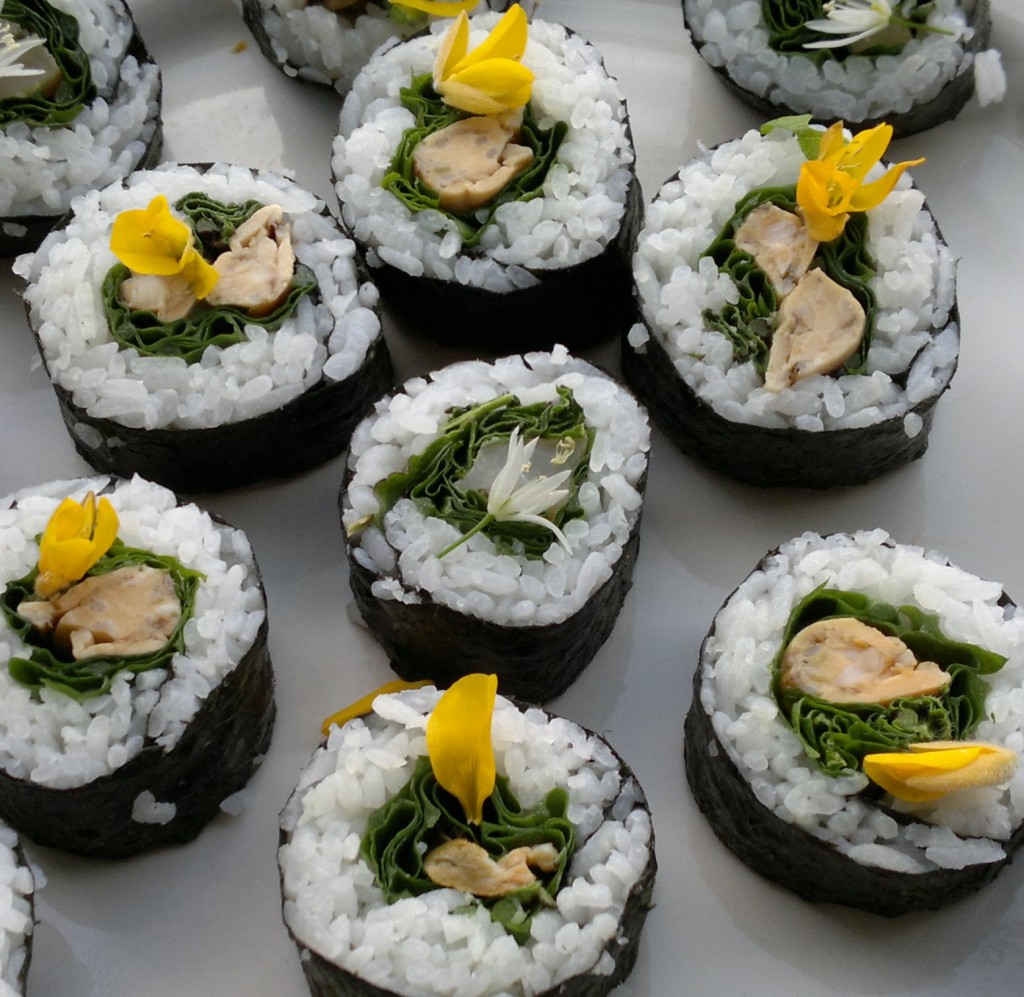Common scurvygrass – Edibility, Identification, Distribution
Cochlearia officinalis
- Edibility – 3/5 – Leaves and flowers. Contrary to nearly every foraging guide, I rate this plant highly provided its pungent wasabi flavour is applied judiciously. Harvested in spring and summer it is very pungent, often with an unpleasant chemical back-taste, but come autumn and winter it often mellows to more like a mustardy-spinach flavour, though this can vary from plant to plant. The flowers in spring offer a milder flavour – great as a garnish or scattered through salads. Later the globe shaped seed pods are succulent while still green, but very pungent indeed – too much for most tastes.
- Identification – 3/5 – Small (1-5cm diameter) glossy, heart/kidney shaped leaves with distinct veins on individual stalks growing in low rosettes. A similar species in terms of leaf shape is lesser celandine which is (mostly) edible, not specifically coastal (though not uncommon growing through coastal grass/hedgerows) and has much less fleshy leaves. As both scurvy grass and lesser celandine flower early in the spring (usually March in much of the UK), confusing them is unlikely – scurvy grass has the typical cruciferous white (sometime slightly pink) flowers typical of much of the brassica family, while lesser celandine has the yellow buttercup-like flowers of the ranunculaceae.
- Distribution – 5/5 – Coastal from strand line to machar and salt marshes, and cliffs, often spreading inland on gritted roadsides – the central reservations of motorways are often carpeted with it.
- Season – Biennial/perrenial – mature leaves in spring and summer can be overpowering.
- Ecology – The hermaphrodite flowers are pollinated by bees, flies, and beetles – a good early source of nectar. It is also noted for attracting wildlife, and some have observed that it appears to thrive near otter haul-out points (perhaps liking the ground disturbance the otters bring, combined with their fertile spraint?), though it is so abundant everywhere around the Galloway coast it would be hard to note a clear correlation.
The flavours and textures of some wild foods can be challenging to our modern palettes. We have got used to the easy sweetness of tame vegetables, while importing piquant spices from abroad to make them more exciting. This is a real shame, as we have an abundance of strongly flavoured, health-giving plants all around us that we have lost – or have yet to acquire – the knowledge and skill to use. Scurvy grass is one such plant.
It is a member of the large brassicaceae family, which includes sea kale, bittercress, common and greater cuckoo flower, sea radish, mustards and of course all the very familiar cultivated vegetables that go towards “meat and two veg”. Traditionally, scurvy grass has been the poor relation of all of these and only really makes it into foraging books because it was harvested by sailors to be salted down by the vat-load to help stave off scurvy during long sea voyages. Contrary to many reports, it isn’t actually much higher in vitamin C than many other plants, but fell into favour because it is easy to find and identify, grows coastally, and, most importantly, is available year-round. The flavour is strongly – and potentially overpoweringly – mustardy/horseradishy, which is why it gets such bad reviews.

Scurvy grass. Although this looks very pretty, reddening of the leaves is a sign that the plant is stressed
I find this odd, as other strong wild flavours such as horseradish, watercress and cuckooflower tend to get rave reviews. If used properly as a spice, condiment, pesto ingredient or small proportion of a salad, and at its correct stage of growth and time of year, the full-blooded mustardy punch of scurvy grass can be superb. I see it in an even better light as I don’t find wild horseradish in Galloway, so I use it with beef and blitzed down with the infinitely more pungent sea rocket as a wasabi substitute with wild coastal sushi. Kapow! Also, there is no holy law decreeing that “seasoning” must comprise of salt and pepper – try chopping scurvy grass up, drying and crumbling.
Generally, I avoid it or use it in even smaller quantities when its leaves are deep green, thick and fleshy – this generally occurs in spring and summer. When the leaves are small I find them an excellent wayside nibble to tickle the tastebuds – but only a nibble!
Related Posts:
- An Introduction to the Brassica Family for Foragers
- Coastal Wild Foods
- Weed Salads
- Orache – Edibility, Identification, Distribution, Ecology




5 Comments
I mix scurvy grass in with other salad leaves, goes well in a salad. It is ready to pick now, late January around the Wash but not ready on the Solway yet.
We just found some on the river Towy but its sweet (baby leaves) growing near a field of cuckoo flower brassicae
Should we dry it for seasoning or use in salads ?
Maybe a bit of both…? Its good to experiment and find out what works for you! 🙂
How spicy is it compared to hairy bittercress?
It is much more pungent than hairy bittercress. In this post – https://gallowaywildfoods.com/hairy-bittercress-identification-edibility-and-distribution/ I discuss the relative pungency of different cardamine species. Scurvygrass is more pungent than all of them.
Mark.